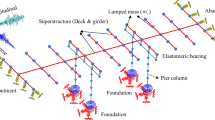Abstract
In several existing dams alcali–silica reaction (ASR) during several decades of service life, or diffused micro-cracking (due to concrete ageing and/or past extreme loads, such as earthquakes) give rise to deterioration of concrete stiffness and to correlated reduction of its strength. An inverse methodology is presented herein apt to identify damage in concrete dams on the basis of hydrostatic loading, measurements by traditional monitoring instruments, such as pendulums and collimators, and artificial neural networks trained by means of finite-element simulations. The arch-gravity dam referred to in this study is sub-divided into homogeneous zones, to which a constant Young modulus is attributed as unknown parameter which quantifies possible damage. These elastic moduli are estimated on the basis of pseudo-experimental data and identification procedures. After a suitable ‘training’ process, artificial neural networks (ANNs) are employed for numerical solutions of the inverse problem, and their potentialities and limitations are examined to the present purposes. In particular, they turn out to be robust and practically useful in the presence of information which are scarce quantitatively (few available measurements) and/or qualitatively (large noise-to-signal ratio).
Similar content being viewed by others
References
Abaqus. (2003). Release 6.3. Theory and User’s manuals. Hibbit, Karlsson and Sorensen Inc., Pawtucket, RI, USA.
T. Ahmed E. Burley S. Rigden A. Abu-Tair (2003) ArticleTitleThe effect of alkali reactivity on the mechanical properties of concrete Construction and Building Materials 17 123–144 Occurrence Handle10.1016/S0950-0618(02)00009-0
R. Ardito P. Bartolotta L. Ceriani G. Maier (2005) ArticleTitleDiagnostic inverse analysis of concrete dams with statical excitation Journal of the Mechanical Behavior of Materials 15 IssueID6 381–386
H. Bui (1994) Inverse Problems in the Mechanics of Materials: An Introduction CRC Press London
Darbre, G. and Kobelt, A. (2000). Health monitoring of dams: Objectives and predictive models. In Proceedings of the 6th International Workshop on Material Properties and Design. AEDIFICATIO Publishers, Freiburg, pp. 159–180.
H. Demuth M. Beale (1998) Neural Network Toolbox for use with Matlab The Math Works Inc. Natick, USA
R. Fedele G. Maier B. Miller (2005) ArticleTitleIdentification of elastic stiffness and local stresses in concrete dams by in situ tests and artificial neural networks Structure and Infrastructure Engineering 1 IssueID3 165–180
S. Haykin (1999) Neural Networks. A Comprehensive Foundation EditionNumber2 Prentice Hall Upper Saddle River, NJ, USA
ICOLD. (2001). Evaluation of AAR (Alkali – Aggregate Reaction) effects on the structural behaviour of an arch dam: Interpretation of the measured behaviour and forecasting of the future trend. In: 6th International Benchmark Workshop on Numerical Analysis of Dams:Salzburg (Austria).
G. Maier R. Ardito R. Fedele (2004) Inverse analysis problems in structural engineering of concrete dams Z. Yao M. Yuah W. Zhong (Eds) Proceedings of the 6th World Conference of Computational Mechanics WCCM VI, Beijing (China) Invited Semiplenary Lecture Tsinghua University Press and Springer-Verlag Beijing 97–107
Maier, G., Lettieri, M. and Piola, L. (2005). In situ mechanical characterisation of dam concrete and stress state by dilatometric measurements and inverse analysis. In: Abstract Book, 11th International Conference on Fracture ICF XI (Turin). p. 395.
Z. Mróz G. Stavroulakis (Eds) (2005) Parameter Identification of Materials and Structures Springer Verlag Wien
H. Rhim (2001) ArticleTitleCondition monitoring of deteriorating concrete dams using radar Cement Concrete Research 31 363–373
P. Schwesinger F. Wittmann (Eds) (2000) Present and Future of Health Monitoring AEDIFICATIO Publishers Freiburg
M.B.H. Sherali C. Shetty (1993) Nonlinear Programming. Theory and Algorithms John Wiley & Sons New York
R. Swamy M. Al-Asali (1988) ArticleTitleEngineering properties of concrete affected by alkali-silica reaction ACI Materials Journal 85 367–374
A. Tarantola (1987) Inverse Problems Theory Methods for Data Fitting and Model Parameter Estimation Elsevier Applied Science Southampton
Z. Waszczyszyn L. Ziemiański (2001) ArticleTitleNeural networks in mechanics of structures and materials – new results and prospects of applications Computers & Structures 79 2261–2276 Occurrence Handle10.1016/S0045-7949(01)00083-9
Z. Waszczyszyn (Eds) (1999) Neural networks in the analysis and design of structures Springer Verlag Wien
L. Ziemiański B. Miller (2000) ArticleTitleDynamic model updating using neural networks Comput. Ass. Mech. Eng. Sci. 4 68–86
Author information
Authors and Affiliations
Corresponding author
Rights and permissions
About this article
Cite this article
Fedele, R., Maier, G. & Miller, B. Health Assessment of Concrete Dams by Overall Inverse Analyses and Neural Networks. Int J Fract 137, 151–172 (2006). https://doi.org/10.1007/s10704-006-6582-7
Received:
Accepted:
Issue Date:
DOI: https://doi.org/10.1007/s10704-006-6582-7




